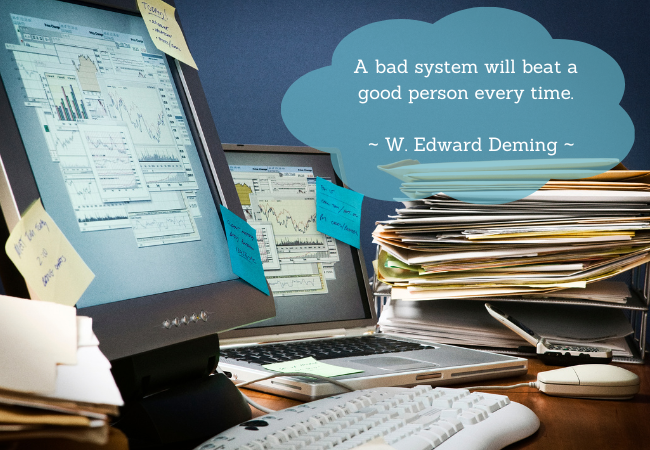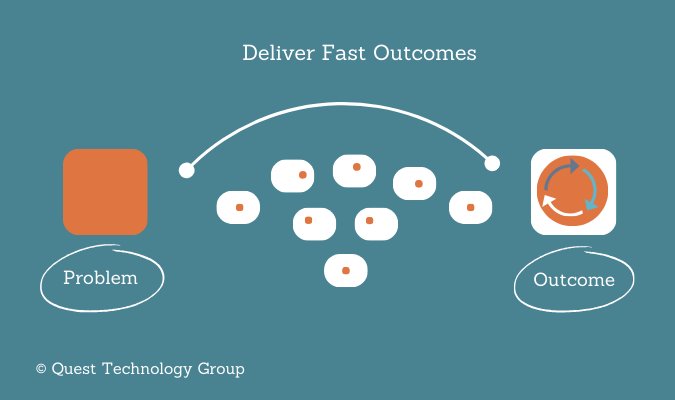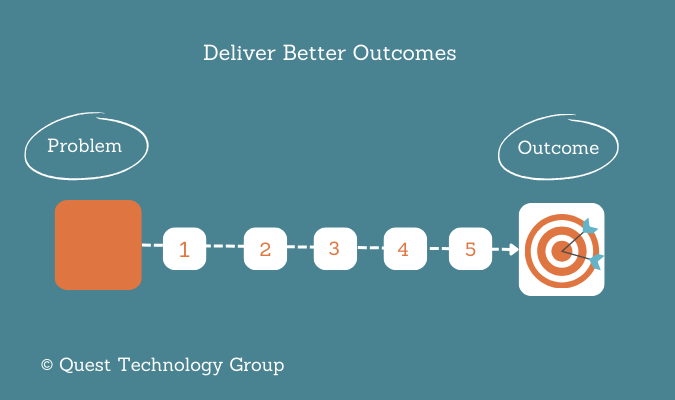Elon Musk's 5-Step Process Algorithm to Evaluate Initiatives

Who hasn't had a client push back when you've presented them with the best, most obvious (to you, anyway) solution to their problem? Everything is moving along with textbook precision—
They've described their problem and its impact on their business.
Together you've walked through the steps to turn this problem into the positive outcome they want.
They've agreed to your terms to make it happen.
And then, out of nowhere, their uncertainty derails everything.
What happened is one important, missing element in the problem-solving equation -- what will your client have to give up when they adopt your solution?
Human nature being what it is, the avoidance of loss is greater than the prospect of potential gain. When we eliminate a client's problem, we ask them to stop doing something they are comfortable doing.
It doesn't matter if this is an activity they despise. They know it's not in their best interests or they wouldn't be committed to fixing it in the first place. But it's a we've-always-done-it-this-way habit, and familiar habits are not easily given up.
When we're in problem-solving mode with our clients, we seize the opportunity with the best intentions. We want our clients to experience the benefits our well-constructed solution delivers as quickly as possible. It's the ideal relationship scenario we all seek.
But a rush to finish overlooks the hidden old habits and poorly defined requirements that lead to resistance later.

In Walter Isaacson's new book Elon Musk, he shares what Musk calls his algorithm. This 5-step process is Musk's go-to system for evaluating the effectiveness and efficiency behind a proposed initiative. Regardless of your opinion about Musk the person, you have to admit that the man does know how to execute on a massive scale.
Walking your clients through this simple process uncovers their hidden security blankets before they become unseen roadblocks. One important note -- each of the 5 steps must be completed in order.
"Each should come with the name of the person who made it. You should never accept that a requirement came from a department, such as the "legal department" or the "safety department". Then you should question it, no matter how smart that person is. Requirements from smart people are the most dangerous, because they are less likely to questions them."
I especially love that last sentence for so many reasons. Smart people overthink simple things. They like to make simple solutions more complicated because they like solving big, complex problems. Sometimes the problem is an easy one-and-done solution that doesn't need to go any farther.
Real Example
I recently shared with you in a weekly email our web services platform changes. Because a reliable, established, trustworthy framework was non-negotiable, it was easy to sink into mental mayhem. To be fair, it was a complicated project that, once started, could only roll one way. It was more than our business at risk. Our clients were making the changes too.
Without realizing it, we applied this 5-step process to our planning.
This is where you uncover the old process habits that are going to appear later. Start removing as much as you can and see what happens. As Musk says, "You may have to add them back later. In fact, if you do not end up adding back at least 10 percent of them, then you didn't delete enough."
Real Example
In our web services project, we started with a step-by-step list of every task involved in supporting our current framework. It was easy to pinpoint the tasks we hated doing, the ones that we repeatedly labeled as there-has-to-be-a-better-way activities. Delete we did.
You can see why this step relies on step 2 being completed. How often have you invested way too much time streamlining a process or task that didn't need to be done in the first place.
Real Example
With our detailed list, we were able to evaluate alternative providers objectively. Could we achieve the same result with less time and expense?
One of the tasks we dreaded was provided through a third-party service. The process was tedious, error prone, and time-consuming so it became a priority in our evaluation. The result -- with our new web services provider, the same task is completed with one live person phone call in a matter of minutes.
Continuous productivity and efficiency gains balanced with quality are cornerstones for Musk. While most of us aren't launching on a SpaceX scale, the economics for our clients are no different.
Incremental improvements that lead to the optimal outcome happen because you've helped your client shed – or at least gradually come to terms with letting go of – old and wasteful habits.
Real Example
An unexpected outcome of our web services change was the drastically improved start to finish time to bring a new client onboard. We were focused on reliability, security, scalability, and overall performance. What we didn't anticipate were the improvements gained from eliminating a surprising number of old tasks.
With the convenience of grabbing a piece of technology that (seemingly) solves the problem, it's easy to jump to this step first. Even the best tools will only do their best job when they have the right job to do. Automating tasks, processes, and systems that don't need to exist at all can be avoided with this simple 5-step process.

By the way, the outcome of our web services far exceeded our expectations.
Monthly expenses were reduced by more than 90%. Zero downtime during the switch. No more wasted time on outdated tasks. Faster response time for our clients. The 5-step process works.
What happened is one important, missing element in the problem-solving equation -- what will your client have to give up when they adopt your solution?
Human nature being what it is, the avoidance of loss is greater than the prospect of potential gain. When we eliminate a client's problem, we ask them to stop doing something they are comfortable doing.
It doesn't matter if this is an activity they despise. They know it's not in their best interests or they wouldn't be committed to fixing it in the first place. But it's a we've-always-done-it-this-way habit, and familiar habits are not easily given up.
Before You Start Solving Your Client's Next Problem
When we're in problem-solving mode with our clients, we seize the opportunity with the best intentions. We want our clients to experience the benefits our well-constructed solution delivers as quickly as possible. It's the ideal relationship scenario we all seek.
But a rush to finish overlooks the hidden old habits and poorly defined requirements that lead to resistance later.

In Walter Isaacson's new book Elon Musk, he shares what Musk calls his algorithm. This 5-step process is Musk's go-to system for evaluating the effectiveness and efficiency behind a proposed initiative. Regardless of your opinion about Musk the person, you have to admit that the man does know how to execute on a massive scale.
Walking your clients through this simple process uncovers their hidden security blankets before they become unseen roadblocks. One important note -- each of the 5 steps must be completed in order.
Step One: Question Every Requirement
"Each should come with the name of the person who made it. You should never accept that a requirement came from a department, such as the "legal department" or the "safety department". Then you should question it, no matter how smart that person is. Requirements from smart people are the most dangerous, because they are less likely to questions them."
I especially love that last sentence for so many reasons. Smart people overthink simple things. They like to make simple solutions more complicated because they like solving big, complex problems. Sometimes the problem is an easy one-and-done solution that doesn't need to go any farther.
Real Example
I recently shared with you in a weekly email our web services platform changes. Because a reliable, established, trustworthy framework was non-negotiable, it was easy to sink into mental mayhem. To be fair, it was a complicated project that, once started, could only roll one way. It was more than our business at risk. Our clients were making the changes too.
Without realizing it, we applied this 5-step process to our planning.
Step Two: Delete Any Part Or Process You Can
This is where you uncover the old process habits that are going to appear later. Start removing as much as you can and see what happens. As Musk says, "You may have to add them back later. In fact, if you do not end up adding back at least 10 percent of them, then you didn't delete enough."
Real Example
In our web services project, we started with a step-by-step list of every task involved in supporting our current framework. It was easy to pinpoint the tasks we hated doing, the ones that we repeatedly labeled as there-has-to-be-a-better-way activities. Delete we did.
Step Three: Simplify and Optimize
You can see why this step relies on step 2 being completed. How often have you invested way too much time streamlining a process or task that didn't need to be done in the first place.
Real Example
With our detailed list, we were able to evaluate alternative providers objectively. Could we achieve the same result with less time and expense?
One of the tasks we dreaded was provided through a third-party service. The process was tedious, error prone, and time-consuming so it became a priority in our evaluation. The result -- with our new web services provider, the same task is completed with one live person phone call in a matter of minutes.
Step Four: Accelerate Cycle Time
Continuous productivity and efficiency gains balanced with quality are cornerstones for Musk. While most of us aren't launching on a SpaceX scale, the economics for our clients are no different.
Incremental improvements that lead to the optimal outcome happen because you've helped your client shed – or at least gradually come to terms with letting go of – old and wasteful habits.
Real Example
An unexpected outcome of our web services change was the drastically improved start to finish time to bring a new client onboard. We were focused on reliability, security, scalability, and overall performance. What we didn't anticipate were the improvements gained from eliminating a surprising number of old tasks.
Step Five: Automate
With the convenience of grabbing a piece of technology that (seemingly) solves the problem, it's easy to jump to this step first. Even the best tools will only do their best job when they have the right job to do. Automating tasks, processes, and systems that don't need to exist at all can be avoided with this simple 5-step process.
Wrapping It Up

By the way, the outcome of our web services far exceeded our expectations.
Monthly expenses were reduced by more than 90%. Zero downtime during the switch. No more wasted time on outdated tasks. Faster response time for our clients. The 5-step process works.
Thanks for Stopping By on Wednesday
Discover what other successful company leaders know.
Join our community of tech savvy business leaders. We share information, knowledge, tools, resources, and a connected community to help you and your business thrive.
 Linda Rolf is a lifelong curious learner who believes a knowledge-first approach builds valuable, lasting client relationships.
Linda Rolf is a lifelong curious learner who believes a knowledge-first approach builds valuable, lasting client relationships. She loves discovering the unexpected connections among technology, data, information, people and process. For more than four decades, Linda and Quest Technology Group have been their clients' trusted advisor and strategic partner.
Tags: Business Strategy
